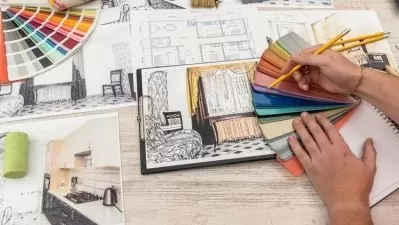About Interior DesignLearn More
Interior designers bring life and color to indoor spaces. A course in interior design teaches you the basics of turning a humble room into a showstopper. Learn how to choose color schemes, select and arrange furniture, and accessorize like a pro. Experienced designers can take online interior design classes to find new inspiration for future endeavors. Udemy offers a range of beginning and advanced interior design courses online.
Sort by:
Sorting
The newest
Most visited
Course time
Subtitle
Frequently asked questions about Interior Design
Interior design describes the process of planning layouts for indoor spaces — think homes, workspaces, or public areas — with special consideration to health, function, safety, and ambiance. Because of this, interior designers must understand building codes and structural requirements while having a deep appreciation for textiles, space planning, and complimentary colors. Sometimes, interior design is just one part of a larger renovation project, so collaborating with home and building owners and professionals in the fields of architecture, contracting, construction, textiles, and furniture design is quite common.
Several key principles guide the field of interior design. One is balance, which is traditionally achieved through symmetry but can also encompass asymmetry or radial balance (when all design elements radiate from a central focal point). Another principle of interior design is scale, suggesting that the furniture and fixtures in any given room should encompass a range of sizes to make a room appear larger or smaller, depending on the final design goals. Harmony is another guiding interior design principle; it dictates that every element in a room should share at least one uniting feature, such as color, even if the other characteristics contrast. Rhythm, or repetition, is also important for interior design. It shows the value of bringing the same element, such as metal accents, to several areas of any interior design concept. Finally, contrast — in shape, color, or texture — is also key, as this principle creates pops of visual interest.
There are many great apps for interior design. When working in a given space, using an interior design app can help take and store accurate measurements to ensure every design element selected physically and visually fits its intended room. One of the best apps for size and interior design is MagicPlan, a free iOS app that converts photos into accurately measured floor plans. Measured, a free iOS app from Lowes Home Improvement, lets users measure any given space using a phone’s camera and an expanded visual reality feature. To help with room arrangements, the free iOS Roomy app allows users to convert a two-dimensional image of any given item and place it into a three-dimensional space rendering. For assistance in exploring furniture purchases — without entering the actual store — the Room Planner by IKEA is a free iOS app that harnesses the power of virtual reality to explore different furniture configurations in various rooms in any space.
The demand for interior design services is definitely increasing. Interior design services are globally in-demand, meaning choosing a career in this industry offers the opportunity to seek employment anywhere in the world. A career in interior design also gives people the chance to work closely with other professionals and clients, making this field a great choice for those seeking independence and collaborative opportunities.
While interior design and architecture share certain similar goals and principles, they are two separate fields. Architects deal with construction and renovation; architecture involves exterior and interior designing guided by technical requirements and principles of math, science, and other highly specialized skills. Architects must also obtain a specific license to practice architecture. Like architecture, interior design principles often apply when constructing or renovating a space. Unlike architects, interior designers don’t require licenses to practice, though several states will require accreditation before allowing designers to work with clients.





